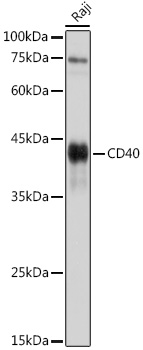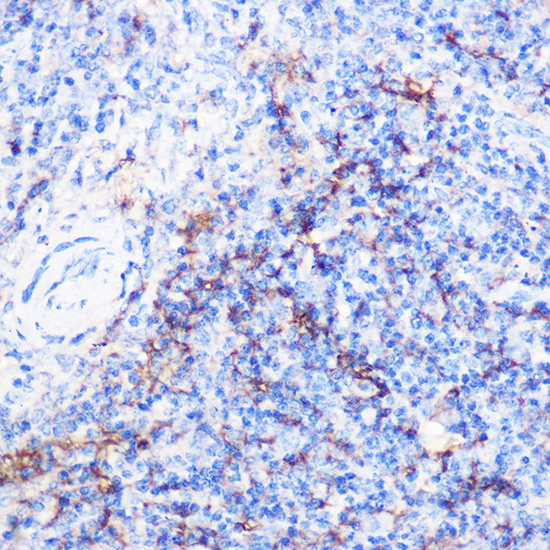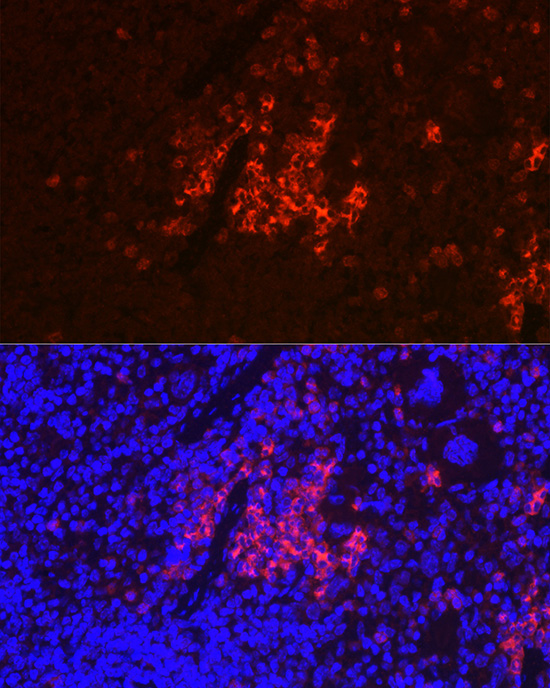Anti-CD40 Antibody (CAB0218)
- SKU:
- CAB0218
- Product type:
- Antibody
- Reactivity:
- Human
- Reactivity:
- Mouse
- Reactivity:
- Rat
- Host Species:
- Rabbit
- Isotype:
- IgG
- Antibody Type:
- Polyclonal Antibody
- Research Area:
- Immunology
Description
| 抗体名: | Anti-CD40 Antibody |
| 抗体コード: | CAB0218 |
| 抗体サイズ: | 20uL, 50uL, 100uL |
| 申し込み: | WB IHC IF |
| 反応性: | Human, Mouse, Rat |
| 宿主種: | Rabbit |
| 免疫原: | Recombinant protein of human CD40 |
| 申し込み: | WB IHC IF |
| 推奨希釈: | WB 1:500 - 1:2000 IHC 1:50 - 1:200 IF 1:50 - 1:200 |
| 反応性: | Human, Mouse, Rat |
| ポジティブサンプル: | Raji |
| 免疫原: | Recombinant protein of human CD40 |
| 精製方法: | Affinity purification |
| ストレージバッファ: | Store at -20'C. Avoid freeze / thaw cycles. Buffer: PBS with 0.02% sodium azide, 50% glycerol, pH7.3. |
| アイソタイプ: | IgG |
| 順序: | Email for sequence |
| 遺伝子ID: | 958 |
| Uniprot: | P25942 |
| セルラーロケーション: | Cell membrane, Secreted, Single-pass type I membrane protein |
| 計算された分子量: | 22kDa/30kDa |
| 観察された分子量: | 45KDa |
| 同義語: | CD40, Bp50, CDW40, TNFRSF5, p50 |
| バックグラウンド: | This gene is a member of the TNF-receptor superfamily. The encoded protein is a receptor on antigen-presenting cells of the immune system and is essential for mediating a broad variety of immune and inflammatory responses including T cell-dependent immunoglobulin class switching, memory B cell development, and germinal center formation. AT-hook transcription factor AKNA is reported to coordinately regulate the expression of this receptor and its ligand, which may be important for homotypic cell interactions. Adaptor protein TNFR2 interacts with this receptor and serves as a mediator of the signal transduction. The interaction of this receptor and its ligand is found to be necessary for amyloid-beta-induced microglial activation, and thus is thought to be an early event in Alzheimer disease pathogenesis. Mutations affecting this gene are the cause of autosomal recessive hyper-IgM immunodeficiency type 3 (HIGM3). Multiple alternatively spliced transcript variants of this gene encoding distinct isoforms have been reported. |
| UniProt Protein Function: | CD40: a member of the TNF-receptor superfamily. This receptor for CD40L mediates a broad variety of immune and inflammatory responses including T cell-dependent immunoglobulin class switching, memory B cell development, and germinal center formation. Defects in CD40 are the cause of hyper-IgM immunodeficiency type 3 (HIGM3). HIGM3 is an autosomal recessive disorder which includes an inability of B cells to undergo isotype switching, one of the final differentiation steps in the humoral immune system, an inability to mount an antibody-specific immune response, and a lack of germinal center formation. Two alternatively spliced isoforms have been reported. Isoform I is a type I membrane protein; isoform II is secreted. |
| UniProt Protein Details: | Protein type:Membrane protein, integral; Receptor, cytokine Chromosomal Location of Human Ortholog: 20q12-q13.2 Cellular Component: cell surface; integral to plasma membrane; plasma membrane Molecular Function:enzyme binding; protein binding; receptor activity; signal transducer activity; tumor necrosis factor receptor activity; ubiquitin protein ligase binding Biological Process: activation of NF-kappaB transcription factor; cellular calcium ion homeostasis; immune response; multicellular organismal development; positive regulation of GTPase activity; positive regulation of I-kappaB kinase/NF-kappaB cascade; positive regulation of MAP kinase activity; positive regulation of protein amino acid phosphorylation; positive regulation of transcription from RNA polymerase II promoter; positive regulation of tyrosine phosphorylation of Stat1 protein; protein complex assembly; regulation of cell proliferation; regulation of immune response; response to lipopolysaccharide; tumor necrosis factor-mediated signaling pathway Disease: Immunodeficiency With Hyper-igm, Type 3 |
| NCBI Summary: | This gene is a member of the TNF-receptor superfamily. The encoded protein is a receptor on antigen-presenting cells of the immune system and is essential for mediating a broad variety of immune and inflammatory responses including T cell-dependent immunoglobulin class switching, memory B cell development, and germinal center formation. AT-hook transcription factor AKNA is reported to coordinately regulate the expression of this receptor and its ligand, which may be important for homotypic cell interactions. Adaptor protein TNFR2 interacts with this receptor and serves as a mediator of the signal transduction. The interaction of this receptor and its ligand is found to be necessary for amyloid-beta-induced microglial activation, and thus is thought to be an early event in Alzheimer disease pathogenesis. Mutations affecting this gene are the cause of autosomal recessive hyper-IgM immunodeficiency type 3 (HIGM3). Multiple alternatively spliced transcript variants of this gene encoding distinct isoforms have been reported. [provided by RefSeq, Nov 2014] |
| UniProt Code: | P25942 |
| NCBI GenInfo Identifier: | 116000 |
| NCBI Gene ID: | 958 |
| NCBI Accession: | P25942.1 |
| UniProt Secondary Accession: | P25942,Q53GN5, Q5JY15, Q5U007, Q7M4Q8, Q86YK5, Q9BYU0 E1P5S9, |
| UniProt Related Accession: | P25942 |
| Molecular Weight: | 22,259 Da |
| NCBI Full Name: | Tumor necrosis factor receptor superfamily member 5 |
| NCBI Synonym Full Names: | CD40 molecule |
| NCBI Official Symbol: | CD40 |
| NCBI Official Synonym Symbols: | p50; Bp50; CDW40; TNFRSF5 |
| NCBI Protein Information: | tumor necrosis factor receptor superfamily member 5 |
| UniProt Protein Name: | Tumor necrosis factor receptor superfamily member 5 |
| UniProt Synonym Protein Names: | B-cell surface antigen CD40; Bp50; CD40L receptor; CDw40; CD_antigen: CD40 |
| Protein Family: | CD40 ligand |
| UniProt Gene Name: | CD40 |
| UniProt Entry Name: | TNR5_HUMAN |




